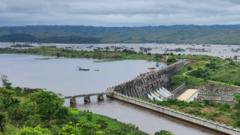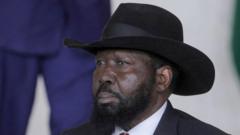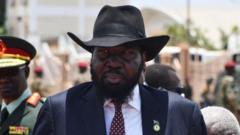**Although the Grand Inga Dam promises extensive benefits for Africa's energy landscape, significant hurdles threaten its realization.**
**Grand Inga Dam: A Visionary Project Stalled by Challenges**

**Grand Inga Dam: A Visionary Project Stalled by Challenges**
**The world's largest hydropower endeavor faces uncertainties as funding and governance issues persist.**
The ambitious Grand Inga Dam project on the Congo River aims to become the world's largest hydropower plant, with the potential to transform energy access across Africa. The Democratic Republic of Congo (DRC) envisions a structure that would double the output of China's Three Gorges Dam, generating sufficient electricity for millions. However, decades of delays, poor governance, environmental concerns, and shaky partnerships have left this grand vision largely unrealized.
Despite its potential to deliver renewable energy and alleviate the electricity deficit affecting approximately 600 million people in sub-Saharan Africa, ongoing skepticism surrounds the project's viability. Following the withdrawal of China's Three Gorges Corporation from the initiative, the future remains uncertain; however, the DRC government insists the project is still progressing. Critics assert that the project holds too many complexities and the DRC's history of corruption could deter potential investors.
The Grand Inga project was first conceived over forty years ago, initially built upon the foundations laid by the operational Inga I and II dams constructed in the 1970s and 1980s. While the idea of additional dams gained traction, only limited progress has been noted. Current capacities are barely average, underscoring the need for further development.
The World Bank’s renewed interest offers a glimpse of hope, marking a shift in negotiation dynamics following a previous withdrawal due to "strategic differences." The involvement of various financial institutions aimed at attracting private investment demonstrates that some stakeholders remain hopeful. Yet, with critical voices pointing out that past experiences may lead to further disappointment, there remains much skepticism regarding the DRC's ability to deliver on its commitments.
Inga III is expected to be the first new construction phase; however, critics underline the need for a cohesive strategy. South Africa aims to import a significant portion of generated energy, sparking debate over whether the dam predominantly serves external markets rather than addressing domestic energy needs in the DRC.
Environmental and social concerns add to the complexity. The displacement of local communities and potential harm to biodiversity remains a contentious issue. Concerns that the previous dams caused disruption, paired with a lack of compensation for past displacements, exacerbate skepticism about justice for local populations.
Despite ongoing negotiations and discussions with potential partners, the vital question remains: can the Grand Inga Dam navigate the myriad challenges that have historically beleaguered major infrastructure projects? The answer may well dictate the future trajectory of energy access in Africa, transforming it from a distant dream into a transformative reality. Until then, the Grand Inga stands as a beacon of untapped potential, waiting for the right moment to surge forward.
Despite its potential to deliver renewable energy and alleviate the electricity deficit affecting approximately 600 million people in sub-Saharan Africa, ongoing skepticism surrounds the project's viability. Following the withdrawal of China's Three Gorges Corporation from the initiative, the future remains uncertain; however, the DRC government insists the project is still progressing. Critics assert that the project holds too many complexities and the DRC's history of corruption could deter potential investors.
The Grand Inga project was first conceived over forty years ago, initially built upon the foundations laid by the operational Inga I and II dams constructed in the 1970s and 1980s. While the idea of additional dams gained traction, only limited progress has been noted. Current capacities are barely average, underscoring the need for further development.
The World Bank’s renewed interest offers a glimpse of hope, marking a shift in negotiation dynamics following a previous withdrawal due to "strategic differences." The involvement of various financial institutions aimed at attracting private investment demonstrates that some stakeholders remain hopeful. Yet, with critical voices pointing out that past experiences may lead to further disappointment, there remains much skepticism regarding the DRC's ability to deliver on its commitments.
Inga III is expected to be the first new construction phase; however, critics underline the need for a cohesive strategy. South Africa aims to import a significant portion of generated energy, sparking debate over whether the dam predominantly serves external markets rather than addressing domestic energy needs in the DRC.
Environmental and social concerns add to the complexity. The displacement of local communities and potential harm to biodiversity remains a contentious issue. Concerns that the previous dams caused disruption, paired with a lack of compensation for past displacements, exacerbate skepticism about justice for local populations.
Despite ongoing negotiations and discussions with potential partners, the vital question remains: can the Grand Inga Dam navigate the myriad challenges that have historically beleaguered major infrastructure projects? The answer may well dictate the future trajectory of energy access in Africa, transforming it from a distant dream into a transformative reality. Until then, the Grand Inga stands as a beacon of untapped potential, waiting for the right moment to surge forward.




















